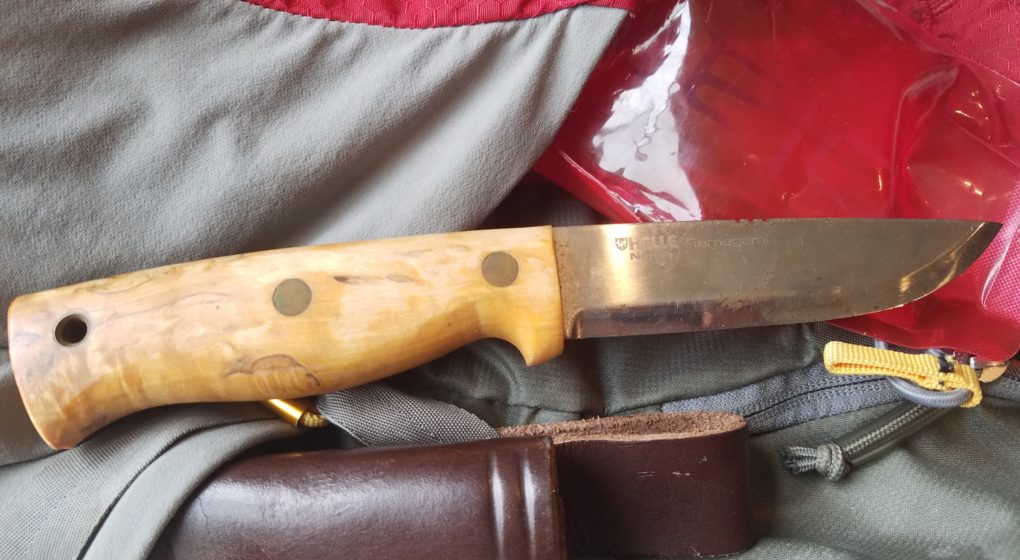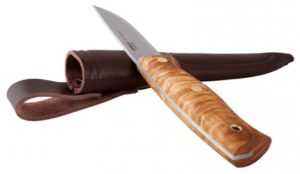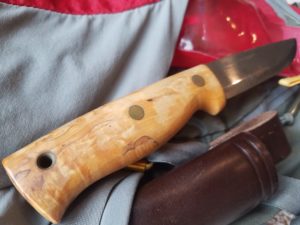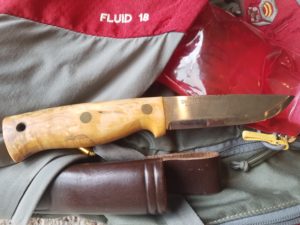
 If you’ve never seen Survivorman then we can say for sure that you’re missing out. As one of the original shows in the modern outdoor / survival TV trend Survivorman, pioneered by Les Stroud, stands above the rest.
If you’ve never seen Survivorman then we can say for sure that you’re missing out. As one of the original shows in the modern outdoor / survival TV trend Survivorman, pioneered by Les Stroud, stands above the rest.
In 2011 Les teamed up with Norwegian knife makers, Helle Knives, to design a “survival” themed knife which turned out to be called the Temagami. Named for a small forested location in northern Ontario, Canada (Les’s home province) this knife has since stood the test of time.
Let’s jump right in to my hands-on review of the Helle Temagami knife designed by Les Stroud:
Specs:
Blade Material: “Triple Laminated Stainless Steel”
Blade Length: 110cm
Handle Length: 120cm
Pins: 3
Tang Style: Partially Full
Blade Style: Drop Point
Handle Material: Curly Birch
Weight: 155g
Sheath: Leather (included)
Models:
Temagami Stainless
The Temagami stainless knife is “triple layered stainless steel” and this is according to Helle’s website and official pamphlet. This was the “original” design and was then followed, later, by the newer model:
Temagami CA
The Temagami CS knife is “triple layered carbon steel” though I’ll get into why this doesn’t make sense in a minute. Other than a slight change to the ergonomics of the handle, Helle didn’t change anything noticeably useful on this model.
Pre-Production Models
I got lucky enough to be involved with the original release of the Helle Temagami and was part of the alpha testing team when the knife first hit the market. You can see that original article here and it goes a bit more into the details of the original release of the knife.
You’ll know you have a pre-production model Temagami knife if you get your hands on one which still has the “thumb grooves” on the spine of the knife. You’ll see in the pictures and videos that mine does and the sheath is a bit different from the new models.
The Good:
A few things I love about the Helle Temagami include:
- Big, secure handle for great grip and leverage
- Razor sharp from the factory
- Three brass pins securing the full tang handle
- Great securely fitting sheath with not buckles or latches
- Beautiful curly birch handle
I can’t speak for the new models, but the early model I still own has a great thick handle with lots of grip and it sounds like they’ve improved the new handles even more. The small “finger guard” at the front acts as a tiny bolster and fits great in the hand.
Factory edge was impeccable, though I did manage to chip my blade almost instantly when cutting through squirrel bones which surprised me due to the fact that squirrel bones are about as resilient as a toothpick. Perhaps an overly hardened blade…
Two full brass pins and a third hollow pin secure the full tang handle and I love that the last pin is hollow. Makes for a great opportunity to add your own cord or lanyard – a niche favorite of survival enthusiasts.
Helle did a great move with the sheath, it’s deep, a secure without any straps or buckles. At first I was hesitant but having owned the knife for 5 years now – it hasn’t fallen out once. I love the way they designed and executed this – simple and effective.
Curly birch was a perfect Canadian themed choice for the handle and the richness of the wood is brought out with a perfect factory finish. Wouldn’t change a thing, great job Helle!
The Bad:
A few things I’m not sure about:
- Overly hardened blade
Some of you may be saying “how can a blade be overly hard” and here’s why.
As mentioned earlier, I had the blade chip on me (tiny chips) when I used it to *gently* chop through a squirrel leg bone. Now, it’s possible this was a misuse of this knife, but I don’t think so and this is the reason:
A knife made primarily for survival enthusiasts, designed by a survival expert, and produced by a knowledgeable knife maker, should not be so hardened that it is prone to chipping, cracking, or fracturing under normal survival type uses. Skinning and harvesting a squirrel, including getting through small bones, is definitely what I would consider “normal survival type use”.
As a knife maker myself I can understand the allure of the perfect sharp blade. I also understand, however, that it’s more important to design a blade of proper steel and heat treatment which matches the purpose for which the blade is designed.
I’m not condemning the knife based on the fragile blade but it does raise question.
The Ugly:
A few things that turn me away:
- Stainless vs carbon vs triple laminated
When the knife first dropped, I wrote a little about the confusion surrounding the “tipple laminated ____ steel”. I won’t go too deep here but this is why it’s confusing, misleading, and brings into question the design of the knife:
Knife makers love to confuse already baffled consumers with silly and, often, unnecessary or useless specs. “Stainless” and “carbon” steel are used to describe the Temagami and Temagami CA respectively on Helle’s website and it’s a little confusing as to what steel is used and on which knife. The main problem here is that we don’t have any disclosure at all about what steel is actually used in the knife and how it’s heat treated.
All steel is “carbon steel” since iron (Fe) and carbon (C) must be combined to create any type of steel. The amount of carbon and other elements in the steel alloy dramatically affect the characteristics of the resulting steel and, combined with heat treatment, result in the final product.
Since all we know about the knives is that they’re redundantly spoken of as “carbon steel” knives, it’s really hard to say anything intelligent about the quality of the blade without some more actual information.
Conclusion:
My thoughts on the Helle Temagami knife are mixed. I respect Les Stroud tremendously for his work and approach to education. I think it would be great to have a little more clarity from Helle about the knife, construction, materials, and process but…
Overall this knife has performed admirably for me and I can’t complain about the product. The fine, ultra hard knife edge is definitely more suited to skinning than chopping or utility work so be extra cautious with how you use the knife.
Don’t hesitate to pick up the Helle Temagami because I think that, at current prices, this knife is worth the value and will split a hair out of the package.



